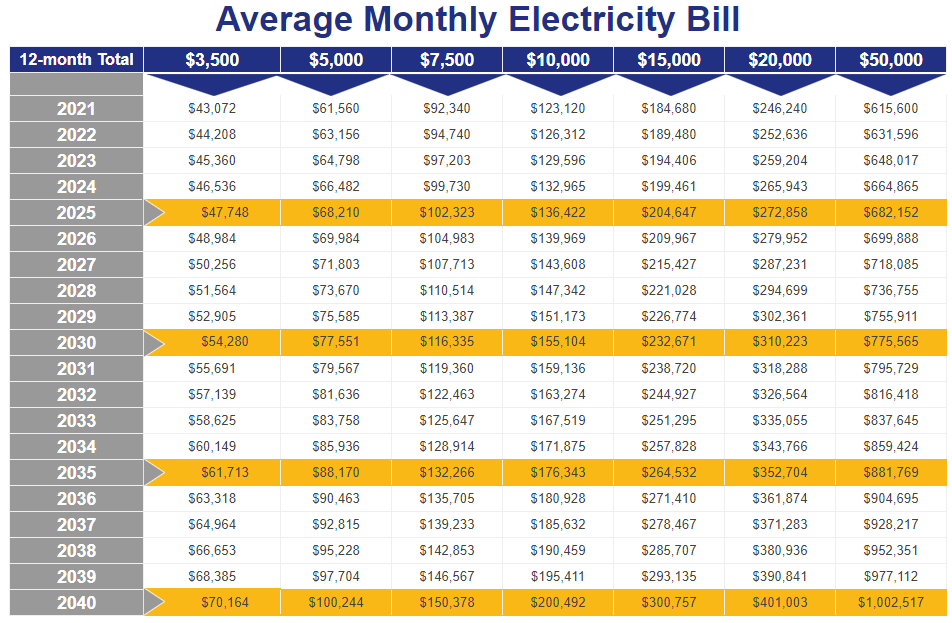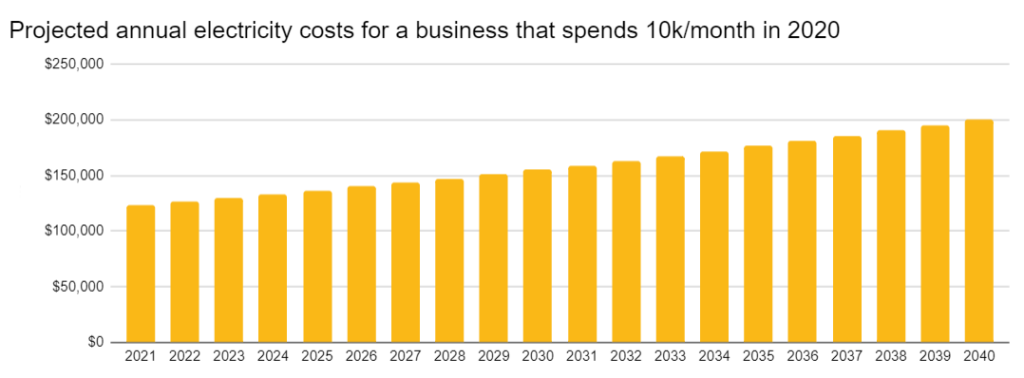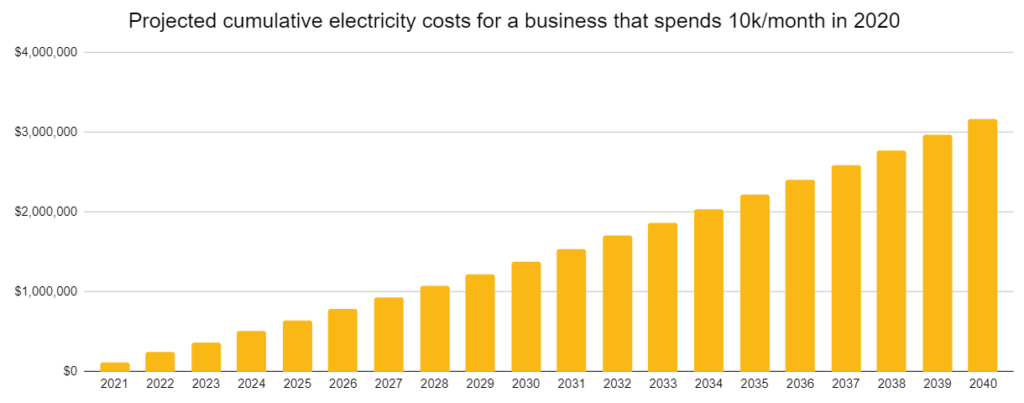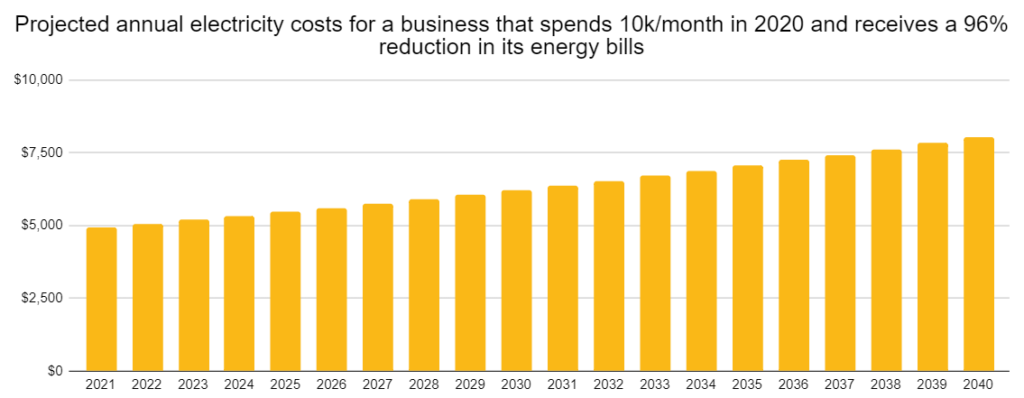In a nutshell:
- Colorado ranks 20th out of 52 states for the most expensive electricity bills;
- Many farmers will pay over $2 million for their electricity over the next 20 years;
- If a farmer currently pays $10,000 a month, they can expect to pay over $155,000/year in 2030 and over $200,000/year in 2040, respectively;
- Renewable energy, such as solar, can significantly reduce energy bills – in some cases by up to 96%.
Lately, Colorado agricultural businesses have been hit with soaring power bills, and quite rightly, many are concerned about what these increases mean several years down the line.
Right now, the average industrial power bill is $7,567, whereas, in 2017, it was only $5,361. That’s an increase of 41% in just six short years!
If we look at Xcel – the largest investor-owned utilities (IOU) company in Colorado – it raised its rates by 4.45% in the first quarter of 2023. This is 1.85% more than the existing overall average of 2.6%.
Many farms will have spent over $3 million in energy costs by 2040. This is money that could have gone into making improvements or expanding the business. Instead, these eye-watering bills prevent many agricultural businesses from reinvesting, which renders them unable to maintain their competitive edge.
Unfortunately, if trends like this continue, then the figures shown in the following tables are very conservative, and we can expect to see even bigger price hikes in the coming years.
Average Monthly Electricity Bill
The table below is based on an average industrial electricity rate cost growth of 2.6% annually for Colorado agricultural and farm businesses.

A Deeper Analysis
The future for Colorado’s farmers looks expensive. Let’s take the middle-of-the-road monthly energy bill of $10,000/month (or $120,000 p.a) as an example.
A farmer paying this much in 2020 is likely to end up paying $155,000/year by 2030 and around $200,000/year in 2040. And if you look at the cumulative costs, this equates to well over $3 million by 2040.
According to the Colorado Department of Agriculture, there are 38,900 active farms and ranches in the state. If each farm paid $10,000/month for their electricity bills, the total farm energy bill for all of Colorado would be over $6 billion by 2030 and almost $8 billion by 2040.
That’s a lot of money to recover and just piles on extra pressure for farmers who are already struggling with rising production and commodity costs. Imagine if that amount of money could be reinvested into the business or counted as net profit instead.


Why Do Colorado’s Electricity Rates Keep Increasing?
When it comes to its energy bills, Colorado has several challenges to consider.
At the back end of 2022, the wholesale price of natural gas shot up, and subsequently, so did people’s energy bills.
For example, Colorado’s largest energy supplier Xcel relies heavily on natural gas to produce its electricity (almost 27% of its output comes from natural gas). During this time, customers of Xcel saw their energy bills double from one month to the next.
Colorado’s other investor-owned utility company, Black Hills Energy, relies on even more gas than Xcel, with over 38% of its energy output produced by this fuel type.
And while gas prices have dipped back down, the cost is still roughly double of what it was this time in 2020.
To add to the problem, coal reserves are low, which means utility companies must rely even more on gas to keep their power plants running. In December 2022, Xcel also reported problems with transporting its coal from mines to power plants, so it had to turn to gas to compensate for this issue.
Overall, and according to data trends and energy costs over time, we don’t expect to see energy bills dropping any time soon. In fact, they’re likely to increase more than our conservative estimates.
What Type of Energy Solutions Exist for Colorado Farmers?
It’s safe to say that continuing along this upward trajectory of price increases is unsustainable. And since Colorado enjoys an average of 300 days worth of sunshine per year, investing in and switching to solar energy presents a very viable solution.
At $400,000 – $500,000 per acre of solar arrays installed, the cost of a solar installation isn’t cheap either, but there is good news regarding this.
The US government recognizes the benefits of solar energy – particularly in the agricultural and business sectors and has therefore provided several ways to help offset the cost of the initial investment:
- A USDA Rural Energy for America Program (REAP) grant is available where farmers and agricultural businesses can apply for a grant up to 50% of the cost of their solar installation (available until 2024), capped at $1 million per applicant
- The Federal Solar Tax Credit provides a 30% investment tax credit (ITC) for businesses that invest in and switch to solar
- The Colorado Enterprise Zone Program can provide up to 6% tax credit for solar installations
- Solar installations can achieve between 28% – 33% depreciation off your taxes
All of this can amount to a whopping 100% return on capital within the first year, which means you can get your entire upfront costs back quickly.
Now, let’s take a look at what your new solar installation can save you year-on-year.
The Significant Savings Achieved By Solar
Amazingly, a farm run on solar energy can see up to a massive 96% reduction in its power bills.
For example, our farmer who initially paid $10,000/month in 2020 will only pay $6,204/year in 2030 and $8,019/year in 2040. Cumulatively, that amounts to $126,814 over the next 20 years, which is only slightly more than 2021’s original annual energy bill!

A final (positive) point here is that for some farmers, energy costs are the largest expense line item the farm has, which makes it crucial to forecast accurately. But, the silver – or rather, golden – lining is Colorado’s abundance of sunlight.
With an average of 300+ days of glorious sunshine, farmers who go solar can have far more predictability in fixing the cost of their energy bills when 96% is offset by solar. And in an uncertain world, who wouldn’t want more certainty and control over something so pivotal to a farm’s success?
Switching to Solar
As you can see, there’s never been a better or more urgent time to switch to solar. Our yearly energy cost increase predictions are conservative, so who knows how much they’ll really increase over the coming years.
Making the move to solar energy can start providing your agricultural business with significant savings right away. And imagine what you can do with all that spare cash?
At 8760 Solar, we know how much Colorado’s farmers benefit from solar. It’s our mission and passion to give agricultural businesses what they need the most – a clean, affordable energy solution and significant savings on their energy bills. And with solar, we can do just that.
If you’d like to find out more about how solar energy can work for your business, don’t hesitate to get in touch. We are happy to provide as much information as you need, as well as give you a no-obligation quote.
We can also run a thorough analysis of your business to uncover how rapidly you can see a return on your solar investment.
To get started, text “READY” to 719 470-0254 or get in touch via email: sales@8760solar.com.
